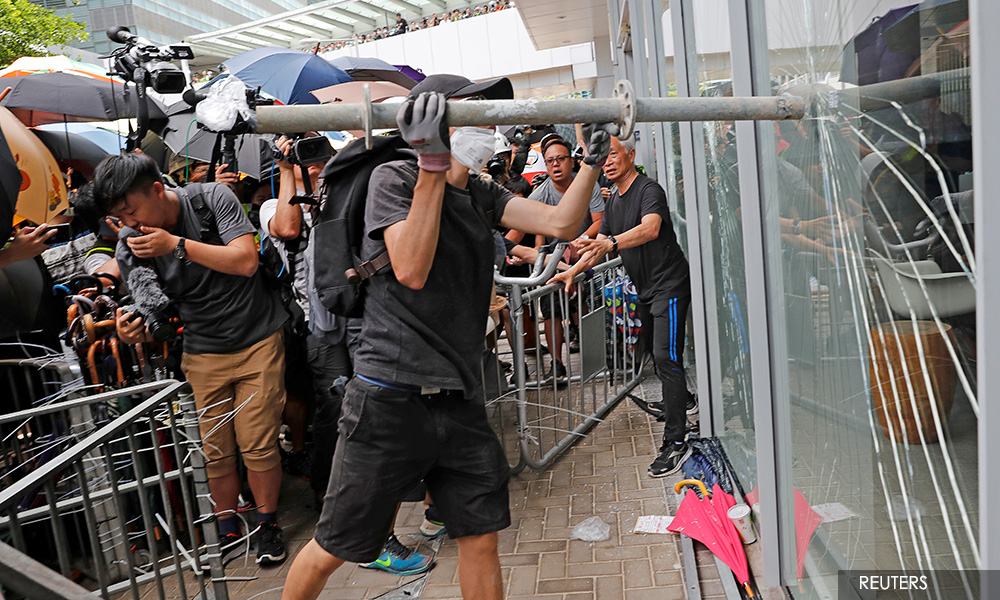On the afternoon of July 1, before protesters in Hong Kong trashed the city's legislature and riot police countered with tear gas, there was a moment that captured the city's state of flux.
A handful of pro-democracy lawmakers, ostensible allies of the demonstrators, tried desperately to stop the young men in hard hats and masks at the front of the crowd from smashing their way into the Legislative Council, known as LegCo.
"What use are you guys as lawmakers?" one demonstrator jeered.
"Yes, we are useless," a legislator named Roy Kwong conceded. "We still need to protect you, do you understand?"
"You are not protecting me," the demonstrator retorted. "You are harming the next generation."

Reuters reporter Jessie Pang, a 23-year-old Hong Kong native, was witness to the scene and said it brought her close to tears.
"It was painful to watch," Pang said.
Still, she said, "it was important to let the world see and hear what was happening. The news is not about me, but their stories, so I kept my camera rolling."
During a month of large, unpredictable and sometimes violent protests to oppose an extradition bill that the government had been pushing, Reuters pressed even its financial reporters to help cover the demonstrations.
Then, journalists flew in from around the region for a planned protest march on Monday, the 22nd anniversary of the former colony's return to China from Britain.
Nobody could predict what would happen, but the backdrop was tense. One major issue was that with no clear protest leader, it was often hard to know where and when the next action would unfold.
Tip-off message
On Monday, the main event was supposed to be a peaceful protest march.
However, hours before the procession started, Taipei-based Reuters photographer Tyrone Siu, in Hong Kong to reinforce, saw in a Telegram messaging group that protesters were headed to the legislative council complex. He tipped off Reuters TV, which quickly moved teams there.
Pang was with demonstrators outside a government ceremony to mark the handover anniversary on Monday morning. She, too, headed to LegCo as word of the gathering there spread around lunchtime.
In the early afternoon, protesters started trying to break into the LegCo building.

Reuters photographer Thomas Peter, down from Beijing, chronicled the protesters as they took turns in the heat and humidity to pound at the thick, tempered glass of the building with makeshift battering rams and hammers, like miners at an urban coal face.
Surrounding the demonstrators were others holding up open umbrellas to shield them from cameras that might produce images or footage that the police could later use as evidence - as they had in previous protests.
The crowd of thousands that had gathered chanted in Cantonese: "Go Hong Kongers!"
When demonstrators finally cracked through the LegCo entrance, they widened the openings and swept away some of the glass so that the crowd could pour in. It was around 9pm and police inside had retreated.
"The words I heard most throughout the protests were 'stay safe!'" Peter said.
"Even when the protest turned into a riot and people were smashing through glass and metal into the LegCo building, I had people repeatedly come up and warn me that it was dangerous here. When I replied that I would stay, they usually told me to stay safe and thanked me for being here."
Protesters were wary of being identified and prosecuted. Nearly all wore face masks and many in the crowd refused to be photographed or quoted in stories by name. Reporters had to be careful to respect their wishes.
Three hours after the break-in, police returned in force and dispersed the crowd with tear gas.
John Ruwitch, Reuters Shanghai bureau chief who was helping with coverage in Hong Kong, watched the police counter-attack and was swept away with the fleeing crowd, but then doubled back to the legislature.
The demonstrators were gone and police outside let him in. Journalists wandered freely, quietly shooting photos of the aftermath. An alarm bell rang incessantly.
At the top of an escalator, overlooking the ransacked foyer, a policeman in riot gear suddenly stopped him and asked for identification papers, Ruwitch said.
"I showed him my press passes and passport, but it wasn't enough," he said.
The policeman insisted he could not stay without a LegCo pass.
Another officer intervened and they let Ruwitch go, perhaps aware of how out of place it was to enforce such a rule at 2am after all that had happened earlier.
Pang also finished her shift in the early hours of Tuesday and headed home, trying to make sense of what she'd borne witness to as a journalist and a Hong Konger.
"My arms were irritated by the pepper spray in the air and my legs were so tired ... but nothing compared with the pain I felt with my people," she said later.
"I don't think it's a weakness to admit we have emotion. We are human before we are reporters."
- Reuters

